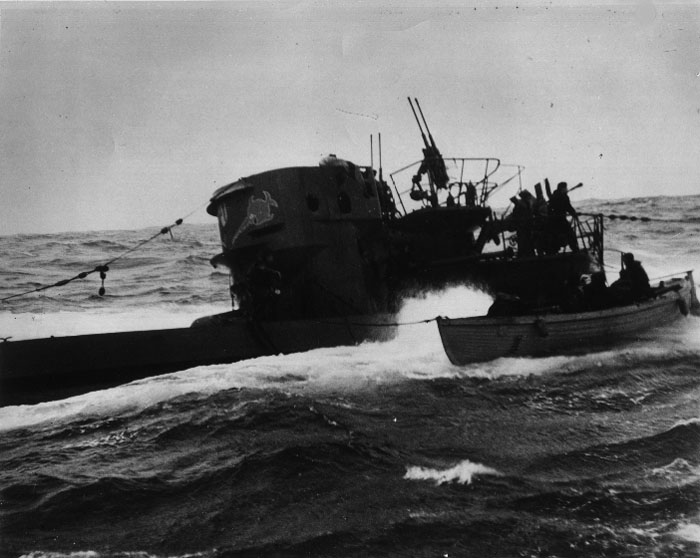
U-744 surfaced and was boarded by HMC ships Chilliwack and St. Catharines. [Wikimedia]
Escorting the convoy were HMS Icarus, a destroyer, HMCS St. Catharines and four corvettes HMC ships Chaudière, Gatineau, Chilliwack and St. Fennel. They were about to take part in the second longest U-boat hunt of the Second World War.
Gatineau’s asdic (sonar) detected a U-boat on March 5. Immediately, the escorts, joined by British corvette HMS Kenilworth Castle, began to attack. U-744, commanded by Oberleutnant zur See Heinz Blischke, dove deep, manoeuvring to escape his attackers through that night and the next day.
“I was on depth charges,” Charles Gaal of Chaudière said in a Memory Project interview. “They had what they called a creeping attack. They’d steam very slowly…and drop a depth charge…One ship directed you with their sonar, or asdic as we called it then. But U-744 was down around 900 feet and it took us 32 hours to get him up.”
Depth charges—explosive-filled canisters weighing as much as 1,300 kilograms—were rolled or dropped off a ship’s stern in a pattern in the area of a submerged U-boat. When the canisters sank to a pre-determined depth, the explosives detonated in an attempt to sink the submarine or damage it enough to force it to the surface.
U-744 surfaced at 3:20 p.m. on March 6 and was an immediate target. Chilliwack scored several hits, one of which killed Blischke. The sub crew surrendered.
The corvettes launched boarding parties, hoping to seize code books and documents as well as pick up the 40 survivors, now prisoners of war. Several boats capsized in rough seas.
The U-boat was too damaged to tow, and Icarus finished U-744 off with a torpedo at about 6:30 p.m.
“We had seven prisoners in the torpedomen’s mess,” said Gaal, “and they were all young kids like the rest of us. Just like looking in a mirror. Well, they became buddies.”
Advertisement






















